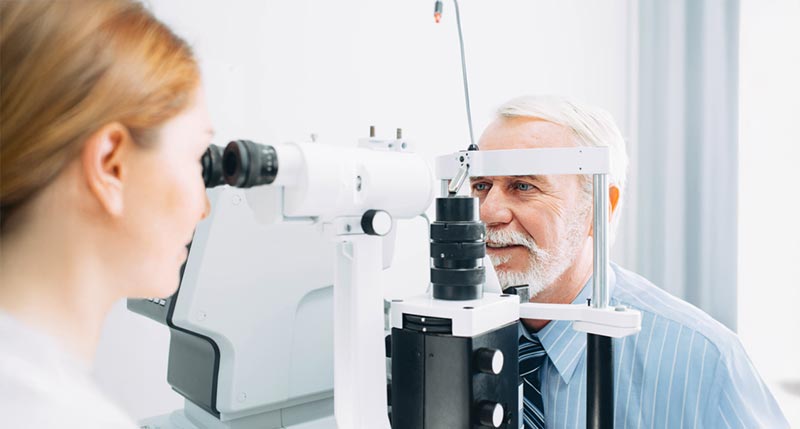“An ounce of prevention is worth a pound of cure.”
Benjamin Franklin made that statement in 1735 to applaud Boston’s fire prevention strategies and encourage his city, Philadelphia, to adopt similar methods to prevent destructive fires.
Frankin’s statement points out how much easier it is to prevent a problem (like a fire) than to solve one once it has started.
Similar to a raging fire, diabetic eye disease is better prevented than “solved” — since once vision loss occurs, there is no cure or solution.
What is Diabetic Vision Loss?
If you have diabetes, you are at risk for developing diabetic retinopathy, a complication of diabetes that impacts your vision. It happens when high blood sugar levels damage the tiny blood vessels that feed the structures of the eye. Once the tiny capillaries in the retina are damaged by leaking blood vessels, some vision is lost, and treatment gets much more complex.
As your optometrist, we want you and all of our patients with diabetes or pre-diabetes to understand that preventing early damage to your vision is easier than treating advanced disease.
How to Prevent Diabetic Vision Loss
That’s why it’s important to focus on keeping your blood sugar levels within target range every day. It’s always better to prevent damage from occurring rather than try to reverse a loss of vision — which is often not possible — after it happens.
Studies show that diabetic patients who maintain blood sugar levels within their target range significantly reduce the risk for developing — or worsening — diabetic retinopathy. That’s right: Tight control of blood sugar can slow disease progression.
So, how can you best achieve tight control of your blood sugar? It’s all about monitoring your lifestyle choices. Technology can help.
Let’s explore two modern tools for diabetics and compare the information they provide.
A1C vs. CGM: What’s the Difference
So many acronyms, right? Here is what these acronyms mean:
A1C is a blood test, performed in a lab or your doctor’s office. It’s a cumulative measure of your average blood sugar levels over the past two or three months. Your A1C number is a percentage, and for most people, the target is to get it below 7%. So, A1C is an “average” of your past blood sugar levels. It gives you a big picture overview of the blood sugar control you achieved in the past few months. That’s useful information, but it’s in the past, so there is nothing you can do about it other than change your habits going forward.
A Continuous Glucose Monitor (CGM) is a small device that contains a sensor to measure blood sugar levels in real time. You wear it on your skin, and it checks your blood glucose level every few minutes to give a reading of your blood sugar at any given moment. For example, if you eat a slice of birthday cake, then check your blood glucose level, your CGM will tell you how high your levels spiked (and yikes – simple carbs like cake and icing will skyrocket those levels). Wearing a CGM provides a real-time, up-to-the-minute report on your glucose numbers, empowering you to make smart decisions (like choosing NOT to have a second slice).
The Pros and Cons of A1C vs CGMs
So, what does this really mean? Simply put, both tools are useful when trying to control your blood sugar to prevent diabetic vision loss.
Your A1C is a valuable number. It is a report card of your past efforts in controlling blood sugar levels. Many factors go into keeping your levels within target range to achieve an A1C average below 7 — including regular exercise, drinking plenty of water, avoiding sugary drinks and foods, and eating healthfully. But while checking your A1C is relatively simple and inexpensive, it only gives a “big picture” view of your blood sugar control.
Unfortunately, it doesn’t show your daily highs, lows, or blood sugar fluctuations. With blood sugar, the devil is in the details: Two diabetic patients with similar A1C scores can have very different blood sugar patterns. Those patterns can be critical in preventing diabetic retinopathy, because blood sugar spikes and how long glucose levels stay elevated are factors that can damage your vision the most.
However, a CGM sensor gives you real-time information and can help you learn which foods or drinks will spike your blood sugar and risk damaging your eye’s blood vessels. CGMs show you how food, exercise, stressful events, and medications impact blood sugar readings during everyday life.
Knowledge is Power in Diabetes
And knowledge is power: By learning which foods cause dangerous highs, you can limit or avoid those foods in the name of protecting your health and vision. Yes, wearing a CGM can be a more expensive option, but wearing a CGM for even two weeks can provide you with data necessary to make smart choices for years to come.
To sum up:
- A1C is the overall “report card” of your past blood sugar.
- A CGM provides real-time data on how your food choices impact blood sugar.
Both tools are valuable in your blood glucose control journey, and can help protect your vision long-term.
Discipline in controlling your blood sugar is the No.1 factor governing your diabetic eye disease risk. Vision loss from diabetic retinopathy is usually permanent, because your body cannot regenerate damaged retinal tissue. That’s why diabetic retinopathy is a top cause of blindness in adults.
Your blood sugar levels are within your control. As your eye doctor, we encourage you to be proactive in managing your blood sugar, to improve your vision outcomes and overall quality of life.
It’s also crucial to schedule regular eye exams so we can examine the delicate structures in your eyes and monitor for early signs of damage. We look forward to seeing you soon, so we can help you continue to see your best.

